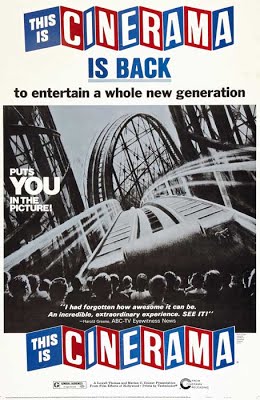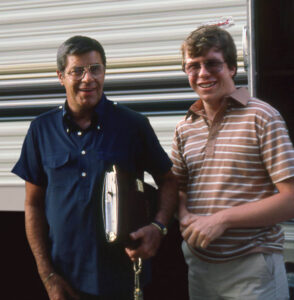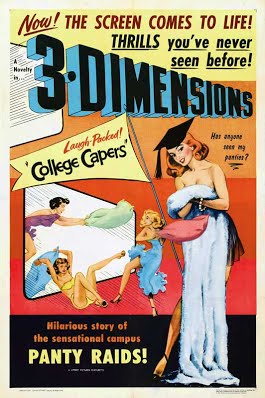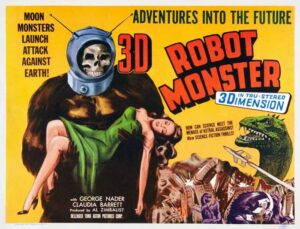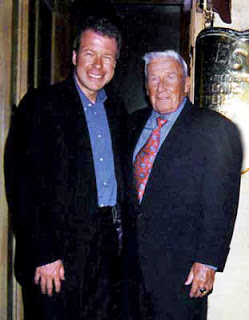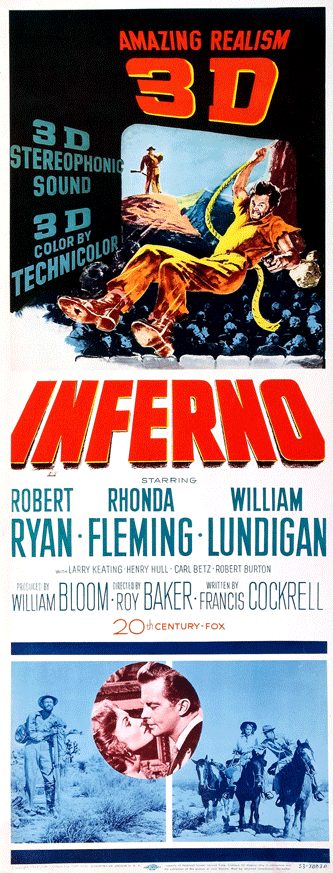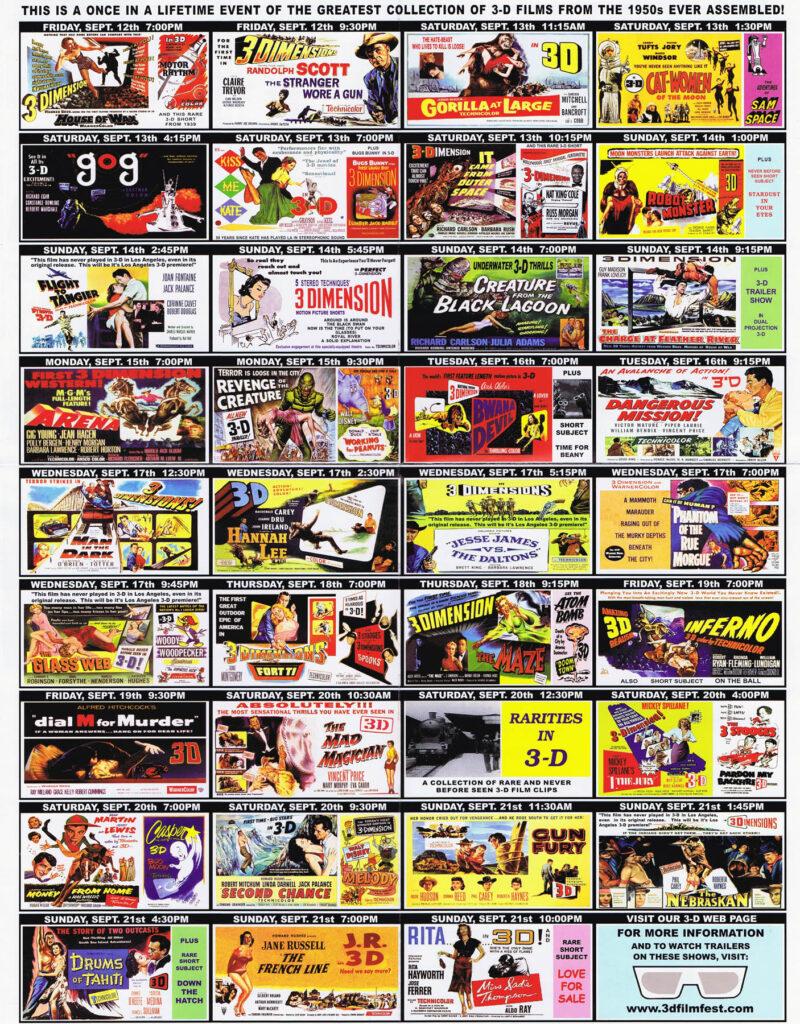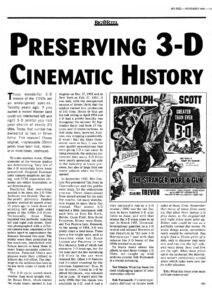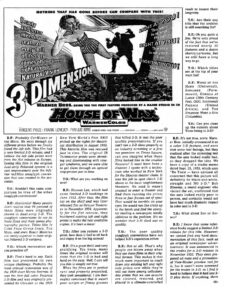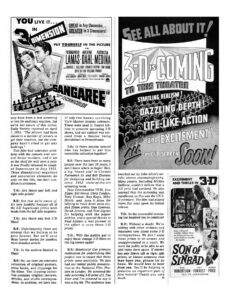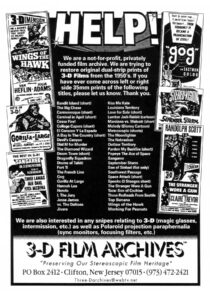A Bit about Us and Why We Do What We Do
My name is Bob Furmanek and I am founder of the 3-D Film Archive. I never set out to save rare 3-D films, nor would I have believed you 35 years ago if you told me the preservation of these unique prints was to fall into my hands. Life can be funny that way.
It’s been a long and wild journey that first began on a spring day in New York City 39 years ago. Fate, timing and sheer luck have all played a role in this crazy story. Let me take you back to that fateful day and tell you how it all happened.
It was May of 1973 and my dad had taken me into New York City for my 12th birthday. We were waiting for a train to the American Museum of Natural History and a huge poster on the subway platform caught my eye. It announced “THIS IS CINERAMA IS BACK” and pictured an audience watching a huge wraparound screen with the image of a roller coaster. I was very curious, especially with the bold proclamation, “Puts YOU in the picture!” Now I knew a bit about film, I had been around it all my life. My dad was an avid home movie buff and we even had an 8mm projector and screening room in our basement, but I had never heard of Cinerama and wanted to know all about it. My dad told me all that he could remember and also mentioned seeing 3-D movies back in the 1950’s. He recalled BWANA DEVIL and HOUSE OF WAX and having to wear special glasses for the 3-D effect. The immersive aspect of these movies fascinated me and I wanted to see those films too.
I had a very limited knowledge of 3-D. I owned a View-Master set at the age of five and must have looked at the Batman reels hundreds of times. When I was 9 years old, I read an article about 3-D horror movies in Famous Monsters of Filmland, and there were ads for a couple of films in the Columbia 8mm home movie catalogs. For whatever reason, none of these had made much of an impression on me at that time. But suddenly, I found the audience participation concept most intriguing and I was eager to learn more.
There were no books on 3-D so I began going to the library and looking through film journals for more information. The real technical details, which I was most anxious to discover, were frustratingly elusive. Finally, two years later, I spotted a small ad for a publication on the history of 3-D and immediately mailed one dollar to Texas for a copy.
In addition to my growing fascination with 3-D movies, I was a huge Martin and Lewis fan. I had just watched the ABC television premiere of MONEY FROM HOME on June 15, 1975. The very next day, I received the magazine, “Everything You Wanted to Know About 3-D But Were Ashamed to Ask.” It was written and published by Paul E. Adair, a man who (I was later to discover) had been the first person to ever undertake the difficult task of searching for original 3-D prints.
As I read through the magazine, I was amazed at the amount of 3-D movies made in the 1950’s. I knew of the horror films but had no idea there had been so many westerns, comedies, musicals and even a travelogue in the process. I turned the page and saw ads for MONEY FROM HOME. I thought “Wait a minute, the movie I watched last night was originally in 3-D?” I now wanted to see it that way! Having just watched it flat on TV was disappointing, to say the least.
I was able to find a used copy of Columbia’s 8mm red/blue anaglyph version of THE MAD MAGICIAN and ran it repeatedly for my friends and family. The 3-D effect was somewhat diminished in the anaglyph format but I didn’t care, I was finally able to see something in 3-D! I convinced the teacher in my 8th grade class to let me show it as a special end of school presentation. At that time, 3-D movies were extremely hard to find so the kids had never seen anything like it. That was my first public exhibition for an enthusiastic audience and I was hooked.
Just a few months later on October 16, 1975, I was finally able to see my first vintage 3-D movies on the big screen. The Paramount Theater on Columbus Circle in New York was showing a double feature of IT CAME FROM OUTER SPACE and CREATURE FROM THE BLACK LAGOON. Even though they were presented in the converted anaglyph system (they were originally shown in Polaroid) I was thrilled to finally see them. I sat through the double feature two different times, not knowing if I’d ever have the chance to see them again.
Once again, my classmates were exposed to my three-dimensional obsession. For my 9th grade English class, I submitted an 8 page article, “A Look at 3-D Motion Pictures.” As part of my presentation, I brought in the 8mm projector and ran SPOOKS with the 3 Stooges. They loved it, and that was the only time in Junior High School that I got three A’s for one report!
In January 1976, Monarch Releasing Corporation in New York began distributing the controversial feature film SNUFF. The hype concerning a supposed on-screen murder generated a ton of free publicity and Monarch made a fortune. They looked to acquire other properties a bit more mainstream and wound up buying the rights to Arch Oboler’s 1966 3-D feature, THE BUBBLE. They were planning a re-issue under the more sensational title FANTASTIC INVASION OF PLANET EARTH. Being an aggressive 15 year old and not terribly shy, I called Allan Shackleton, President of Monarch, and somehow talked him into giving me a private screening. On the afternoon of June 30 1976, I saw my first Polaroid 3-D film and it knocked me out. I left the screening room and thought now more than ever; I want to see those films from the 1950’s in their original versions.
Just a few years later, I finally had my chance. I was working weekends at a record store in New York and the Thalia on 95th street was showing a revival of MISS SADIE THOMPSON, SPOOKS and MAN IN THE DARK. I asked my boss if I could take an extended lunch break and go watch a little bit of one film. He reluctantly said yes, but told me not to stay too long. When I saw that first dual-strip 3-D presentation on November 25, 1978, I was hooked. I wound up staying for both features and when I finally got back to the store three hours later; my boss was not terribly pleased with me. He understood that I had my priorities.
Throughout 1979, I was able to see several dual-strip revivals at the Thalia, including an original 1953 left/right pair of IT CAME FROM OUTER SPACE on New Year’s Day. The print had some wear but it was a revelation seeing it in the original Polaroid version. I never wanted to see the anaglyph again.
THE WORK BEGINS
In March 1980, I had my first professional gig in the world of 3-D. I was helping Steve Hirsch at the 8th Street Playhouse put together a major five week 3-D retrospective. It was the first festival of its kind ever attempted and we premiered DIAL M FOR MURDER in New York in 3-D. (Contrary to what the ad claimed, it had played NY flat in 1954.) I quickly got my initial taste of studio apathy. We tried to book the same print of IT CAME FROM OUTER SPACE that I had seen just a year earlier at the Thalia. The booker at Universal told me, “Oh that was an old print, we junked it. But we do have a brand new print and you don’t need two projectors for this one.” I was livid! How could they have destroyed what might have been one of the last surviving prints of the original dual-strip version? Sure, it had some wear and there were lots of black frames inserted to keep the prints in sync, but it was such a vast improvement over the headache inducing red/blue anaglyph.
I was angry and frustrated.For the same festival, we tried to get some of the rare Paramount titles, such as SANGAREE, FLIGHT TO TANGIER and MONEY FROM HOME. We were told that left/right prints were available so we announced them for the festival and put them on the advance poster. Just a few days before the opening, we were notified that only one side could be found in the vaults so we could not run them in 3-D.It was then I knew that something had to be done. It was clear the studios were not concerned or taking the proper steps to preserve their 3-D libraries. The seeds for 3-D Film Archive had been planted…
The unique and irresistible opportunity to work for a living legend took me to Hollywood in 1984. My boss was now Jerry Lewis and with his connections and influence within the industry; doors began to open for me. There was a renewed interest in 3-D at that time, and various stations around the country were getting high ratings with anaglyph broadcasts of some vintage titles. The studios began digging into the vaults to see what they had and what they could sell. Time had not been kind to those 30 year old elements. Negatives had not been preserved and the few remaining prints were in terrible shape. The films needed attention and I was in the right place at the right time.
I began poring through studio files and laboratory records. Some of my discoveries were heartbreaking. While doing research at the old Consolidated Film Industries laboratory in Hollywood, I learned that all of the elements for the 1953 Lippert Pictures short COLLEGE CAPERS (left/right 35mm negatives and fine grains) had been destroyed ten years earlier. They were stored under a closed account (Jezebel Productions) and were placed in an outdoor trailer on the parking lot. One of the major archives was supposed to pick up the materials but after several un-returned phone calls, the films were junked. I have often wondered what other rare films were destroyed in that trailer. Thankfully, we have since located an anaglyph print of this entertaining comedy short.
Sometimes, important elements survived just by sheer luck. I had become close friends with Bud Abbott Jr. and he shared the following story. He was working as an optical technician at one of the film laboratories. He went to work one morning and found the master 35mm right side fine grain of THE MAZE sitting outside on the loading dock. He asked why it was there and his manager said “That’s just a duplicate element and the distributor said to junk it.” Bud was savvy to 3-D and informed the manager that it was the opposite eye of the other fine grain that was still in the vault. Thanks to Bud, the distributor was contacted and the master fine grain was saved.
My research continued for the next several years but it wasn’t until 1990 that I began my quest to seek out original left and right side prints. It happened quite by accident. I was doing work at a film storage facility and was looking through some vaults on my lunch break. Sitting way up on a top shelf and covered in dust were three reels marked MONSTER FROM MARS. I had never heard of the film but what really got my attention was the word “right” on the reel band. It was a good ten to twelve feet off the ground and I didn’t have a ladder so I had to balance myself on adjoining shelves to reach the top. The effort paid off because it turned out to be a complete right side 35mm print of ROBOT MONSTER, a film that had not been seen in good quality 3-D since 1953!
I began digging though the vaults in the hope of finding the other side. Sure enough, several days later, I found another print that was also sitting on a top shelf covered in dust and dirt. The reels had not been touched for forty years and the account had been closed for decades. Upon inspection, I was thrilled to discover it was a complete left side. Had I not found those six reels at that time, they would have eventually been destroyed when that storage facility went out of business.
ROBOT MONSTER does not have a good reputation for quality so I was not expecting to be impressed with the 3-D cinematography. I put both prints through a synchronizer and painstakingly replaced any missing footage with black film to keep them in perfect sync on projection. My screening room was not set up for 3-D so I took the prints to a facility in New York. When the film finally hit the silver screen, we were shocked. The quality of the outdoor stereo photography was as good as any of the major studio films from 1953.
I discovered that Medallion TV Enterprises did not have complete elements when they created the red/blue anaglyph version in the early 1980’s. On their video master, entire sections of the film went flat and that’s the way it’s been seen ever since. However this 1953 print (with the exception of a few minutes of flat stock footage) was entirely stereoscopic. I realized then the importance of tracking down original release prints as they might be the last available record of the complete 3-D versions. The search was on!
THE ARCHIVE IS BORN
For the next 13 years, I combed through vaults, basements, storage units, laboratories, warehouses and theaters. I reached out to collectors around the world to locate any original left or right side 35mm prints. It was an immense undertaking but it had to be done.
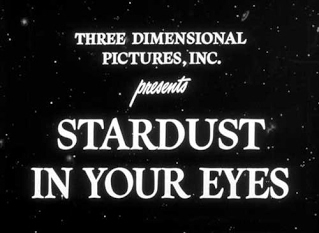
My efforts paid off: by 2003, the 50th anniversary of 3-D’s breakthrough year, my 3-D Film Archive held the world’s largest collection of vintage stereoscopic film materials. I had found and re-combined thirty dual-strip features and two dozen shorts, trailers, tests and cartoons all dating from 1922 through 1955.Among my earliest discoveries were the lost comedy shorts HAWAIIAN NIGHTS with Pinky Lee and STARDUST IN YOUR EYES with Slick Slaven. 3-D researchers and historians had never even heard of these obscure titles. The Pinky Lee film was never released in 3-D.
While doing research for an Abbott and Costello book that I co-authored, I found a passing reference to the short in Universal-International’s 1953 Daily Committee Meeting notes. Further research confirmed that the left/right 35mm negatives did exist but had never been printed. The Slick Slaven short was found in a closed storage account at Movielab in Hollywood and was originally intended as an opening short to ROBOT MONSTER. It would have eventually been destroyed.
By the end of the decade, I was ready to begin sharing my discoveries. On July 27 1999, I was honored to present the UK 3-D premiere of Mickey Spillane’s I, THE JURY at the National Film Theatre in London. (It had opened flat in the UK on its original 1953 release.) Mickey Spillane was there for the special event and expressed his surprise and delight that a 3-D print had survived. He was so pleased with the discovery; he took me to dinner at Rules, London’s oldest and one of its finest restaurants. He could not have been nicer. He treated me like an old friend and it was a delight spending time with him. In November 1999, the Archive was profiled and I was interviewed in the Big Reel. (The full interview is at the conclusion of this article.) That same month, I received a very special phone call from London.
Director Roy Ward Baker was preparing his auto-biography “The Director’s Cut: A Memoir of 60 Years in Film” for publication in March 2000. He was quite proud of his subtle and dramatic use of stereoscopic cinematography on the 1953 classic INFERNO and lamented the fact that no original 3-D Technicolor prints had survived. (The Dinard British Film Festival saluted Mr. Baker in 1993 and was reduced to showing a flat black and white 16mm print.)
When his editor Tony Sloman told him that I had found original dye transfer Technicolor 35mm left/right prints, he had the publisher stop the presses so he could modify the text! He called personally to express his gratitude and appreciation for my preservation efforts. We spoke for 20 minutes about his work on the film and he asked many questions about my work on the Archive. It was quite an honor.
For three weeks in May 2000, I had the great pleasure of providing eleven features and four shorts to David Packard for screening at his beautifully restored Stanford Theatre in Palo Alto, California. Seeing those original prints on the big screen in a beautiful movie palace with a large and appreciative audience was a tremendous thrill. The discovery and restoration of each print had a story and Mr. Packard encouraged me to share those with his audience. It was a wonderful experience.
In June 2003, I found the only surviving 3-D footage from TOP BANANA, a 1953 comedy starring Phil Silvers and Rose Marie. The film was never released in its stereoscopic version and no 3-D elements are known to survive. The discovery of this brief footage was an important find. More details on the history of this film can be found on our Lost 3-D page.
The Archive’s collection formed the basis of the World 3-D Film Expo held at the Egyptian Theatre in Hollywood in September, 2003. I provided twenty-one of the thirty-four features screened at that event. Surviving cast and crew members as well as film buffs from around the world came to see these one-of-a-kind prints and it was a tremendous success. The second Expo was held in 2006 and I also contributed rare films to that festival. Some of the special guests who attended were Rhonda Fleming, Kathryn Grayson, Tommy Rall, Ray Bradbury, Julia Adams, Jane Russell, Richard Fleischer, Herbert L. Strock, Stan Freberg, Kathleen Hughes, Pat Hitchcock, Biff Elliot, William Schallert, Pat Crowley, Gene Barry, the Bell Sisters, Lorenzo Lamas, Warren Stevens, Ray Evans, Paul Picerni, Slick Slaven, Leonard Maltin, Joe Dante, John Landis, Bob Burns, Quentin Tarantino and many more. Some writers have suggested that both events, with so many Hollywood movers and shakers in attendance, formed the nucleus for today’s 3-D renaissance. Who can say for sure, but I can personally state that it was the crowning achievement for all my years of work in putting the Archive together.
THE ARCHIVE TODAY
Over the past 22 years, I’ve had the good fortune to do 3-D work with NBCUniversal, Paramount Pictures, MGM/Park Circus, 20th Century Fox, Warner Brothers, the Dryden Theater at George Eastman House, the British Film Institute, the Stanford Theater Foundation, UCLA Film & Television Archive and the Academy of Motion Picture Arts and Sciences.
The Archive’s preservation work is ongoing. Most recently, I helped to ensure preservation of the 1954 United Artists feature GOG and have provided important research materials and documentation to Warner Brothers and NBCUniversal on their 3-D libraries.
It’s been a long and bumpy road these past 39 years with many surprising twists and turns along the way. I’ve made some mistakes but overall, I’m very proud of what’s been accomplished.
Thank you very much for allowing me this opportunity to tell my story. This new chapter of the Archive has begun and I’m very excited to now share these stereoscopic treasures with you. With the contributions of my good friends and fellow 3-D historians Greg Kintz and Jack Theakston, I’m very optimistic for our future.
Please keep an eye on this website, our Facebook and YouTube pages for important updates and other information about our ongoing preservation efforts.
Dimensionally Yours,
Bob Furmanek
May 2012




